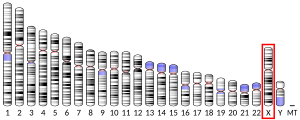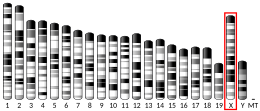From Wikipedia, the free encyclopedia
Protein-coding gene in humans
Melanoma-associated antigen H1 is a protein that in humans is encoded by the MAGEH1 gene .[ 5] [ 6] [ 7]
This gene is thought to be involved in apoptosis. Multiple polyadenylation sites have been found for this gene.[ 7]
MAGEH1 has been shown to interact with Low affinity nerve growth factor receptor .[ 5]
^ a b c GRCh38: Ensembl release 89: ENSG00000187601 – Ensembl , May 2017^ a b c GRCm38: Ensembl release 89: ENSMUSG00000047238 – Ensembl , May 2017^ "Human PubMed Reference:" . National Center for Biotechnology Information, U.S. National Library of Medicine .^ "Mouse PubMed Reference:" . National Center for Biotechnology Information, U.S. National Library of Medicine .^ a b Tcherpakov M, Bronfman FC, Conticello SG, Vaskovsky A, Levy Z, Niinobe M, Yoshikawa K, Arenas E, Fainzilber M (Dec 2002). "The p75 neurotrophin receptor interacts with multiple MAGE proteins" . J Biol Chem . 277 (51): 49101– 4. doi :10.1074/jbc.C200533200 PMID 12414813 . ^ Lucas S, De Smet C, Arden KC, Viars CS, Lethe B, Lurquin C, Boon T (Mar 1998). "Identification of a new MAGE gene with tumor-specific expression by representational difference analysis". Cancer Res . 58 (4): 743– 52. PMID 9485030 . ^ a b "Entrez Gene: MAGEH1 melanoma antigen family H, 1" .
Zhu F, Yan W, Zhao ZL, et al. (2001). "Improved PCR-based subtractive hybridization strategy for cloning differentially expressed genes" . BioTechniques . 29 (2): 310– 3. doi :10.2144/00292st06 PMID 10948432 . Chomez P, De Backer O, Bertrand M, et al. (2001). "An overview of the MAGE gene family with the identification of all human members of the family". Cancer Res . 61 (14): 5544– 51. PMID 11454705 . Strausberg RL, Feingold EA, Grouse LH, et al. (2003). "Generation and initial analysis of more than 15,000 full-length human and mouse cDNA sequences" . Proc. Natl. Acad. Sci. U.S.A . 99 (26): 16899– 903. Bibcode :2002PNAS...9916899M . doi :10.1073/pnas.242603899 PMC 139241 PMID 12477932 . Goehler H, Lalowski M, Stelzl U, et al. (2004). "A protein interaction network links GIT1, an enhancer of huntingtin aggregation, to Huntington's disease" . Mol. Cell . 15 (6): 853– 65. doi :10.1016/j.molcel.2004.09.016 PMID 15383276 . Gerhard DS, Wagner L, Feingold EA, et al. (2004). "The Status, Quality, and Expansion of the NIH Full-Length cDNA Project: The Mammalian Gene Collection (MGC)" . Genome Res . 14 (10B): 2121– 7. doi :10.1101/gr.2596504 . PMC 528928 PMID 15489334 . Ross MT, Grafham DV, Coffey AJ, et al. (2005). "The DNA sequence of the human X chromosome" . Nature . 434 (7031): 325– 37. Bibcode :2005Natur.434..325R . doi :10.1038/nature03440 . PMC 2665286 PMID 15772651 . Rual JF, Venkatesan K, Hao T, et al. (2005). "Towards a proteome-scale map of the human protein-protein interaction network". Nature . 437 (7062): 1173– 8. Bibcode :2005Natur.437.1173R . doi :10.1038/nature04209 . PMID 16189514 . S2CID 4427026 . Fu H, Yang G, Lu F, et al. (2006). "Transcriptional up-regulation of restin by all-trans retinoic acid through STAT1 in cancer cell differentiation process". Biochem. Biophys. Res. Commun . 343 (4): 1009– 16. doi :10.1016/j.bbrc.2006.02.176 . PMID 16574066 .





